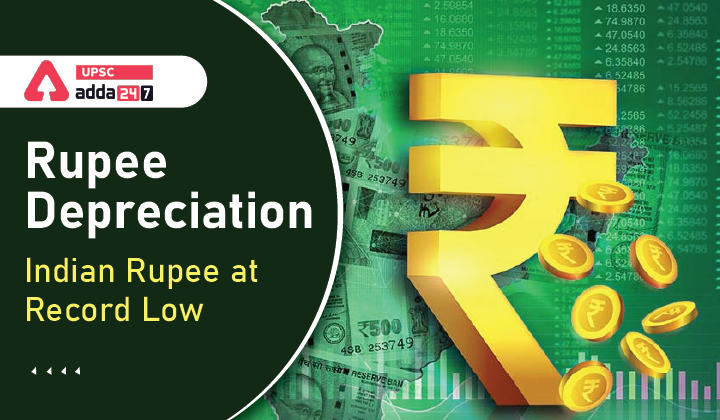Table of Contents
Rupee depreciation UPSC: Relevance
- GS 3: Indian Economy and issues relating to planning, mobilization, of resources, growth, development and employment.
Rupee devaluation: Context
- Recently, Indian rupee recorded a historic low of 79.03 against the US dollar, it has declined nearly 6 per cent since January this year.
2022 में रुपये का मूल्यह्रास: भारतीय रुपया रिकॉर्ड न्यूनतम पर
Rupee depreciation against dollar: Key points
- The depreciation of rupee is expected to impact the various segments of economy such as imports, mainly fuel prices, and push up inflation.
- The Finance Minister, however, said that the Indian currency is relatively better placed than other global currencies against the greenback.
Why rupee is falling?
- Demand and supply: If a country imports more than it exports, then the demand for the dollar will be higher than the supply and due to this, domestic currency like Indian rupee will depreciate against the dollar.
- Russia-Ukraine war: Global disruptions caused by the Russia-Ukraine war is making our imports costly, thus widening the current account deficit.
- Rising inflation: Rising inflation depreciates domestic currency since inflation can be equated with a decrease in a money’s buying power. As a result, countries experiencing high inflation tend to also see their currencies weaken relative to other currencies.
- High crude oil prices: Increasing crude oil prices are further widening our trade deficit thus leading to decrease in the value of rupee.
- Capital outflows from India: The US Federal Reserve recently increased the interest rates, and the return on dollar assets increased compared with those of emerging markets such as India. It has led to outflow of dollars from India to the US.
Fall in Indian rupee: Impact
- Increase cost of raw materials: Since, India imports many raw materials, the price of finished goods could go up thus impacting the consumers.
- Boosts exports: In an ideal scenario, devalued rupee could have led to increase in exports. However, in the current scenario of weak global demand and persistent volatility, exporters are not supportive of the currency fall.
- Inflation: The falling rupee’s biggest impact is on inflation, given India imports over 80 per cent of its crude oil, which is the country’s biggest import.
- Travellers and students studying abroad will have to shell out more rupees to buy dollars from banks.
- Stock market: Rupee depreciation may see foreign investors pulling out of Indian markets, resulting in a decline in stocks and equity mutual fund investments.
Will rupee fall further?
- The rupee is expected to remain under pressure due to strong dollar and elevating inflationary pressure in India.
- Moreover, persistent FPI outflows are also expected to weigh on the currency.
- Additionally, the outlook for the global economy is looking gloomy amid supply chain disruptions, the lockdown in China, and the war in Ukraine, which are expected to keep the safe-haven dollar in demand.
What is depreciation of rupee?
- Currency depreciation, in our case rupee, means that the domestic currency is losing its value against foreign currencies.
- Just like a commodity, a currency is subject to demand and supply fluctuations (in a floating exchange rate system).
- As US Dollar (USD) is the most traded currency in the world, most currencies are benchmarked against USD, including Indian rupee.
- For example, if rupee has depreciated from 70 to 75, it means that earlier when we paid Rs. 70 to buy a product of worth 1 USD, now we are paying Rs. 75 to buy the same product. However, in case of exports, it means we will get Rs. 75 in case of Rs. 70 for selling a product of worth 1 USD.
Read current affairs for UPSC





 TSPSC Group 1 Question Paper 2024, Downl...
TSPSC Group 1 Question Paper 2024, Downl...
 TSPSC Group 1 Answer key 2024 Out, Downl...
TSPSC Group 1 Answer key 2024 Out, Downl...
 UPSC Prelims 2024 Question Paper, Downlo...
UPSC Prelims 2024 Question Paper, Downlo...




